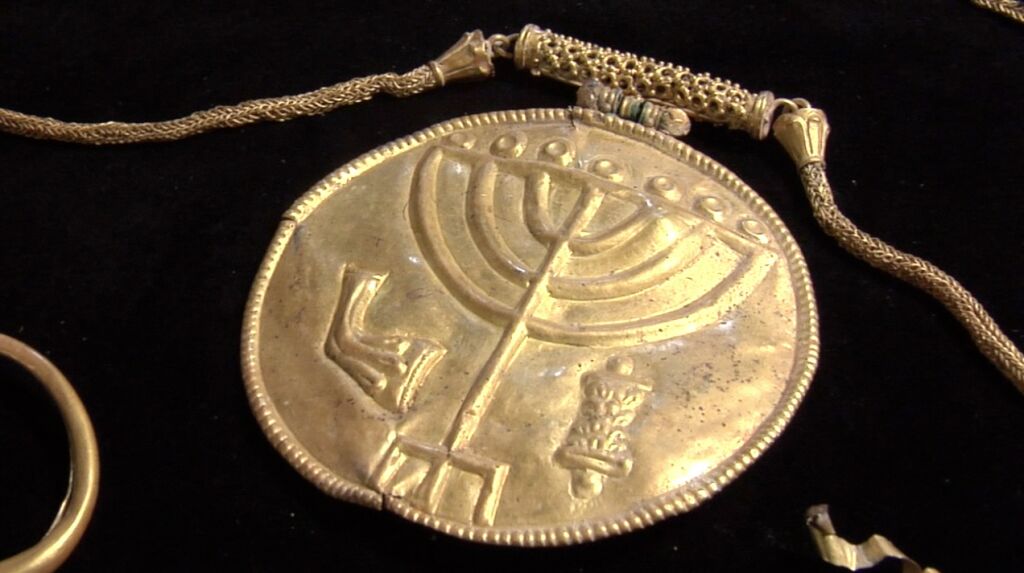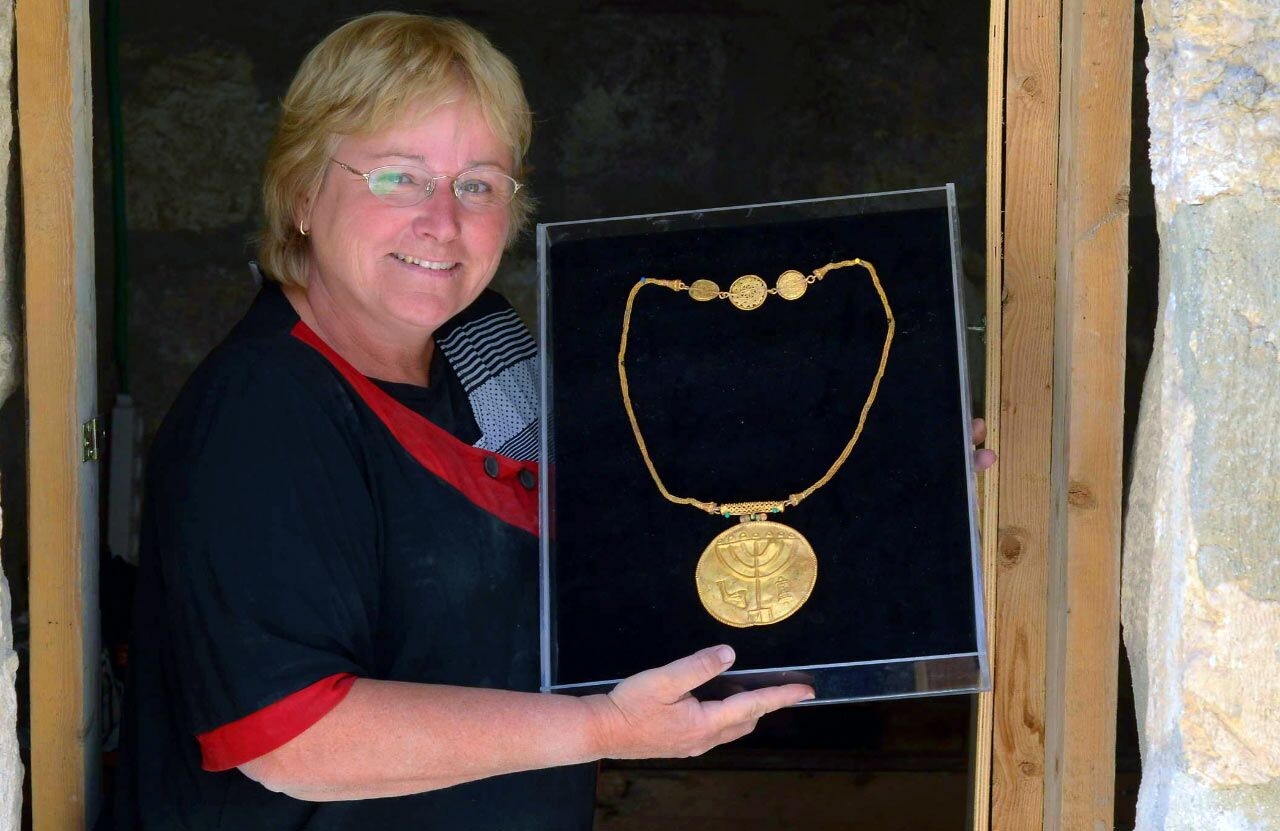Archaeological digs on the Ophel have occurred on and off since the middle of the 19th century. But only in recent years have royal structures been uncovered in Jerusalem that closely correlate to the biblical descriptions of King Solomon’s massive building projects in the books of Kings and Chronicles.
In the 2013 phase of the Hebrew University of Jerusalem Ophel excavations, Dr. Eilat Mazar and her team set out to uncover more remains from the Solomonic period—and they did. But no one expected the most stunning discovery of all to come in the first week of the dig, after excavators had barely broken through the surface of a new area.
There, just a few centimeters beneath modern debris, they began to expose a hoard of rare gold coins, silver and gold jewelry. And among these treasures was a real archaeological gem: a large gold medallion ornamented with a menorah, the iconic Jewish symbol of a seven-branched candlestick.

“This happens only once in a lifetime,” said Dr. Mazar.
This fantastic collection was discovered about 50 yards south of the Temple Mount, inside a Byzantine structure that dates back to the sixth century c.e. It had most likely been carefully packed and hidden by a prominent group of Jews during the Persian conquest of Jerusalem at the beginning of the seventh century c.e.
Just like the massive stones King Solomon used to build his royal complex, this newly discovered treasure, after being buried for 14 centuries, revives a riveting and powerful testimony from a long-forgotten chapter in the 3,000-year-old history of Jewish Jerusalem.
A Fantastic Find
On April 22, 2013, Dr. Mazar and her staff went back into the field to continue the second phase of the renewed Ophel excavations. Just five days in, workers Caridad French and Ahinoam Meyers were excavating in a Byzantine-era structure when they uncovered a large gold earring. As they continued, the second earring appeared, and then a number of gold coins began emerging, strewn across the area.
Further excavation carried out by the team, including Dr. Mazar herself, revealed the menorah medallion buried in a depression in the floor and a cache of jewelry items tucked underneath it. Remnants of fabric found on the items indicate that they were at one time packaged in two separate cloth purses.

The first bundle, containing the menorah medallion and other jewelry, was found undisturbed where it had been carefully hidden in the chalky floor. The second had a more dramatic fate. Its items were found scattered across the floor; apparently there had not been enough time to bury them.
Dr. Mazar and her team believe the menorah medallion, which was attached to a gold chain, was probably used to adorn a Torah scroll—a practice that Jews have been known to do for millennia. If so, the medallion and accompanying items would be the earliest known Torah scroll ornaments ever discovered. This appears to be corroborated by the appearance of the Torah symbol on the medallion itself. A similar medallion displaying a Torah scroll alongside a menorah can be found on display in the Jewish Museum in London, though its origins are unknown. The Ophel medallion, like the London medallion, also depicts a shofar on one side of the main menorah image.
The second bundle held 36 gold coins, two gold earrings, a broken gold-plated silver pendant and a pure silver ingot—probably all items that a Jewish resident of the city had intended to use as some sort of donation/payment. Numismatics expert Lior Sandberg, who examined the coins, concluded that the last possible date for their minting is c.e. 602. Therefore, the gold coins and their accompanying items must have been abandoned sometime after this date. Dr. Mazar postulates that the treasure was abandoned around the time of the Persian conquest of Jerusalem in c.e. 614.
Why Was It Left Behind?
Historical circumstances give us clues as to why such a treasure would have been left in Jerusalem.
After the city fell under Persian control, Jews flocked to Jerusalem, intent on returning and rebuilding their homeland. Some had even assisted the Persians in taking the city, with the promise that they would be allowed to rebuild the temple. However, history recounts that as the Persians’ power quickly waned, so did their support for the Jewish population. To appease the rising power of Christendom, the Persians betrayed the Jews and expelled them from Jerusalem. Sandberg wrote:
The cache was abandoned … most probably after the Persian conquest of Jerusalem and after the Persians changed their attitude to the Jews and allowed their expulsion from the city. The fact that the gold was not properly hidden nor taken back attests to the tragic circumstances that led to its abandonment.
In her new book, The Discovery of the Menorah Treasure at the Foot of the Temple Mount, Dr. Mazar theorizes that the collection of Torah scroll adornments and the purse containing coins and other means of payment accompanied a group of prominent Jews sent as representatives from their community to build a synagogue in Jerusalem.
“It is not inconceivable that it was earmarked as a contribution toward the rebuilding of the temple itself. This we cannot know,” she writes. Certainly, finding this treasure so near to where the temple stood makes this a very real possibility. During this incredibly brief Persian rulership, the Jews did get as far as laying some foundations for the temple and reportedly even made a few sacrifices. The beautiful design and quality of the treasure certainly would have been befitting to temple rebuilding efforts. Dr. Mazar continues: “What is certain is that their mission, whatever it was, was unsuccessful. The treasure was abandoned, and its owners could never return to collect it.”
The menorah medallion and accompanying treasure now take pride of place in the Israel Museum as one of the largest—and certainly most symbolically significant—gold hordes ever discovered in Israel.
_________________________________________
Q&A With Dr. Mazar
Just days before she announced her latest major discovery at a Sept. 9, 2013, press conference, the personnel behind Let the Stones Speak spoke to Eilat Mazar about why these 1,400-year-old treasures are important, and about her contributions to the field of Jerusalem archaeology.
What were some of your thoughts when you first uncovered the medallion?
It truly was amazing. … And then first thing, I remember, What is this doing here? What is that? And the second was, What am I going to do with this gold? It causes trouble. … I immediately started to worry about it.
In your book you theorize that the menorah medallion and other items with it were used as Torah scroll decorations. What led you to this conclusion?
Well, it’s obvious that it’s meant to hang on something. And I believe that there are only two options: It’s meant to hang on somebody, as a decoration, like a priest or somebody who is the head of the synagogue or the one praying with the Torah. It has to be connected to Judaism, of course, because of the seven-candled menorah. The other option was maybe it’s meant to decorate the Torah book. … When we found out that the other symbol [on the medallion] was a Torah book on the other side of the menorah, that option made more sense. It’s not usual, it’s not so common, to see such a symbol beside the menorah.
What was the purpose of the gold coins and other items discovered in the second bundle?
That’s what was amazing about this. We kind of expected at least one, two, some of the coins (we have, altogether, 36 coins)—so we expected some of the gold coins to be in the first purse. But it seems like they were meant to be separated. … And that all brings us to believe that the other purse was meant to be used, not for ornamentation of the Torah scroll, but to be used as money.
I believe that they were messengers and that they were sent for a specific commission. And they were given the money in order to probably build a synagogue. So that money was meant to be used for that purpose.
Of course, these are assumptions. … [T]hat’s what I think now, but we still give ourselves the option to go on more deeply into these types and study more, to see how more accurately we can come to further conclude it.
What significance do you think these finds will have on the world of archaeology and in regard to the history of the Jewish people?
Well, you know, everybody wants to find gold. But it’s not what archaeology is all about. Usually archaeology is very hard work … it’s pottery, it’s walls, stones—nothing like gold.
So, once in a while to find such a treasure, this is great, but I wouldn’t recommend it as if it happened on a regular basis. …
[S]uch a small treasure, relatively small, contains so much information, and it teaches so much. In this case, we can relate it to Jewish people very clearly. There is no doubt. We can relate it to a specific time—there is no doubt about that because the coins are telling us about the specific time …. And the location is very clear, so near the Temple Mount. So we got enough information to base a very good theory and relate it to a specific time—which, we know what became of the Jewish people at that time: They were eager to come and build Jerusalem.
What would you say is your most remarkable find to date?
I don’t think that it’s one item, unless it’s this medallion. The menorah—of course, it’s amazing. But when it comes to the importance of what we did in Jerusalem, archaeological projects that I conducted, I believe it’s the whole thing: the buildings, monumental structures from the time of King David and Solomon. Structures that existed up to the end of the First Temple period—I believe that this is the most important contribution. I’m very proud of that.
To read more details about the discovery of these structures, click here. To purchase Dr. Mazar’s comprehensive book on the Menorah treasure—click here.
